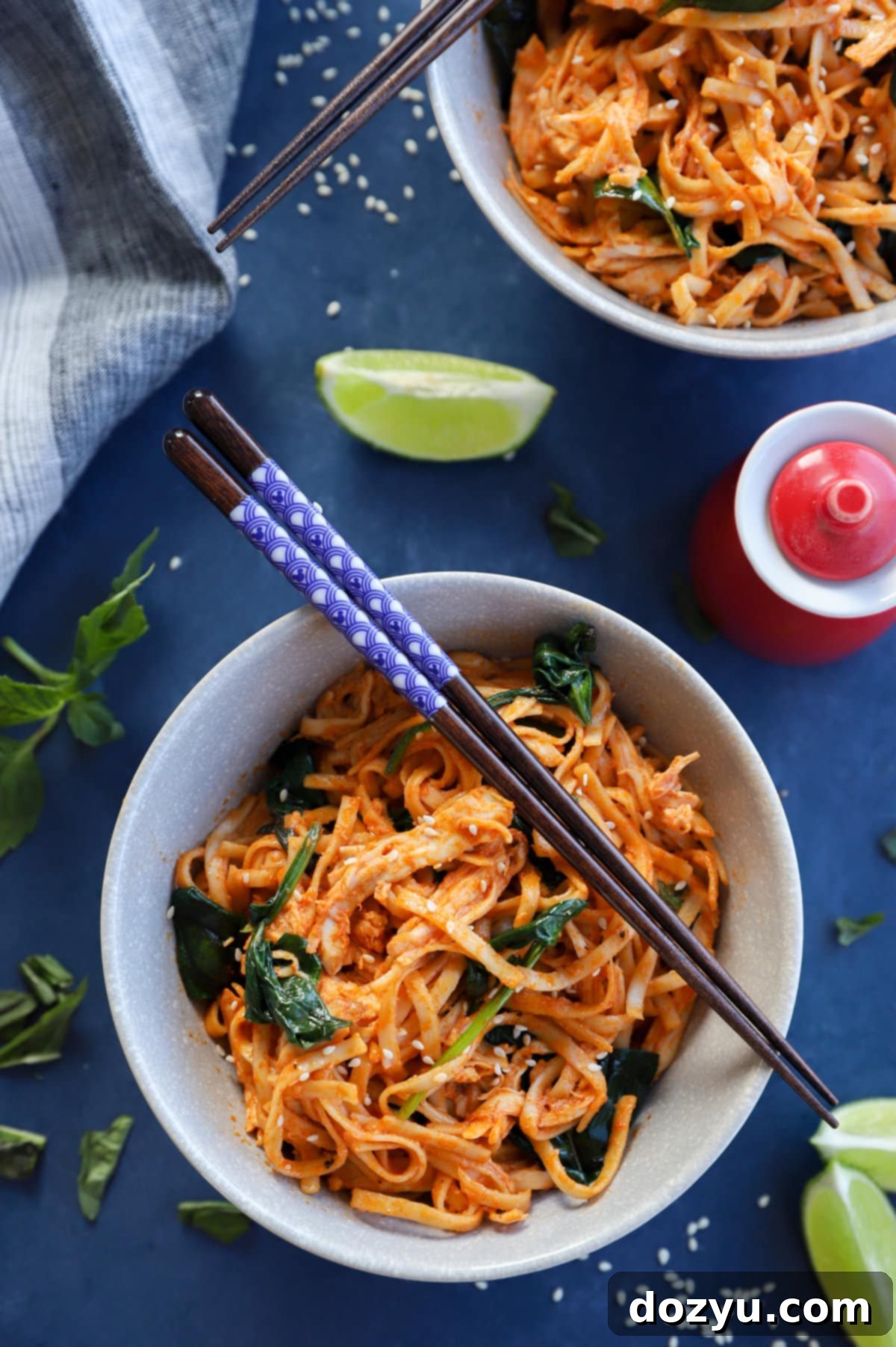Spicy Gochujang Noodles: Your 15-Minute Korean Weeknight Meal Fix
Prepare for a culinary adventure with these incredible Gochujang Noodles! They are wonderfully spicy, lusciously saucy, and bursting with flavor, delivering an authentic Korean-inspired experience right to your dinner table in just 15 minutes. This quick and easy recipe is designed to transform your ordinary weeknight meal routine into something exciting and memorable, proving that delicious, internationally-inspired dishes don’t have to be complicated or time-consuming.
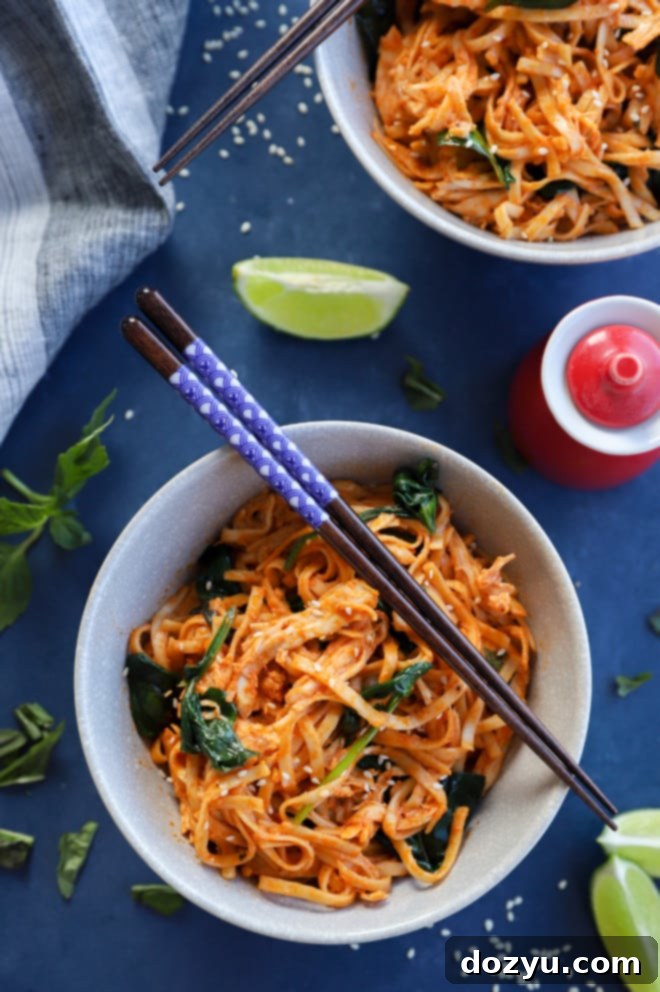
Table of Contents
Toggle
About These Gochujang Noodles: Flavor, Speed, and Customization
Are you searching for an incredibly easy, deeply flavorful meal that truly satisfies? These Gochujang Noodles are the answer you’ve been craving! They come together in a flash, making them ideal for those hectic evenings when time is precious but you still desire a homemade, satisfying meal. This Korean-inspired dish is more than just a quick fix; it’s an exciting gateway to exploring vibrant new flavors that can elevate your culinary repertoire.
Venturing beyond your usual noodle routine might seem daunting, but diving into this rich, spicy, and savory Korean meal is surprisingly simple. With just a few core ingredients and minimal effort, you can introduce a thrilling burst of heat and complex umami to your dinner lineup, opening up a whole new world of tastes and textures. Our saucy Gochujang Noodles are perfectly tailored for any weeknight, ensuring you spend less time cooking and more time enjoying.
What makes this dish truly special is its incredible versatility. It serves as a fantastic foundation for creative cooking, allowing you to easily adjust the spice level, swap out proteins, experiment with different types of noodles, and incorporate a variety of your favorite vegetables. Whether you’re a seasoned chef or just starting to explore intuitive cooking, this recipe empowers you to customize your meal to perfectly suit your preferences. Plus, with a total preparation and cook time of only 15 minutes, you’ll even have a few extra moments to fine-tune the sauce to your exact liking!
If you’re on the lookout for another delightful and weeknight-friendly noodle dish, be sure to explore our Curry Udon with Chicken and Onions for another burst of Asian-inspired flavor.
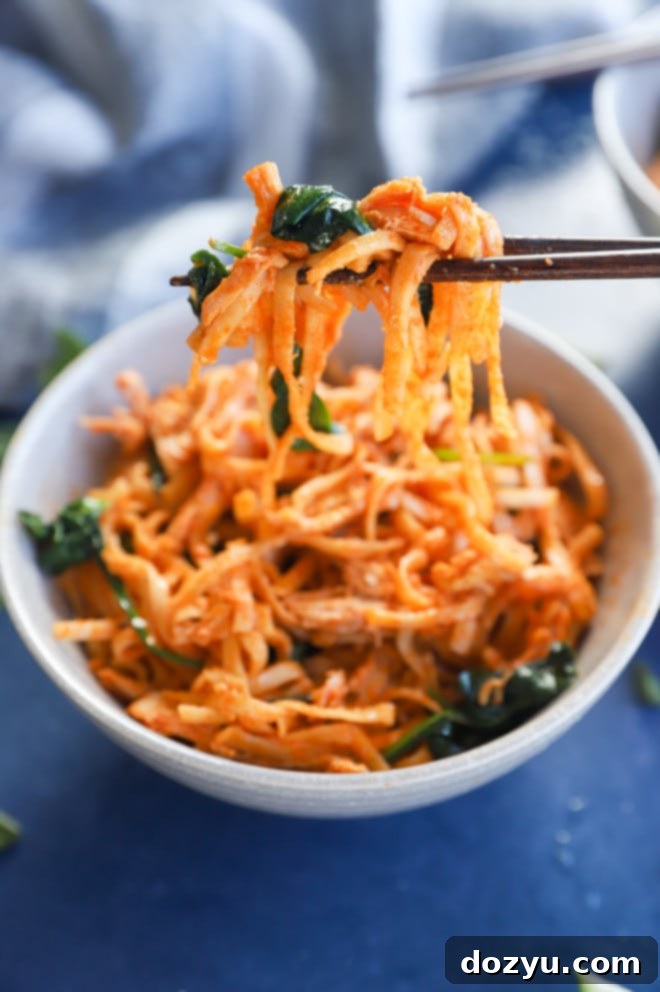
What is Gochujang? The Heart of Korean Spice
At the very core of these sensational noodles lies gochujang, a cornerstone ingredient in Korean cuisine. Gochujang is a deeply fermented Korean chili paste, renowned for its complex and multifaceted flavor profile. Unlike a simple hot sauce, it offers a harmonious blend of intense spice, subtle sweetness, and profound umami, all contributing to its signature savory depth. Its vibrant reddish-brown color and thick, sticky consistency are instantly recognizable, making it a versatile ingredient that can be used as a condiment, a marinade base, or, as in this recipe, the star of a rich, flavorful sauce.
The fermentation process is key to gochujang’s unique character. Traditional gochujang is made from gochugaru (Korean chili powder), glutinous rice, fermented soybeans (meju), malted barley, and salt, which are then fermented over months or even years in large earthenware pots called onggi. This slow process develops an incredible depth of flavor that is spicy yet balanced, and irresistibly savory. It’s what gives many classic Korean dishes their distinctive taste and fiery kick.
Looking for more ways to enjoy this incredible paste? Elevate your dinner with this delicious Gochujang Salmon.
Essential Ingredients for Your Gochujang Noodles
Crafting these delectable Gochujang Noodles starts with a careful selection of fresh, high-quality ingredients. Here’s a breakdown of what you’ll need and why each component is crucial to achieving that perfect balance of Korean-inspired flavors:
- Noodles: The foundation of our dish! While I personally love using lo mein noodles for their satisfying chew and ability to hold sauce, this recipe is incredibly flexible. Any fresh or dried wheat stir-fry noodles will work beautifully. Consider options like thick, chewy udon noodles, or even thinner ramen noodles (without the seasoning packet). For those seeking a gluten-free alternative, rice noodles are an excellent choice.
- Gochujang Paste: This is non-negotiable! Be absolutely sure to use gochujang paste and not gochujang sauce. The paste is significantly more concentrated, pungent, and rich in flavor, which is exactly what infuses this dish with its signature bold taste and medium heat. You’ll find it brings a depth that a diluted sauce simply can’t match.
- Soy Sauce: A staple in Asian cooking, soy sauce adds essential salty, umami notes. Feel free to use your favorite brand. If you’re catering to gluten sensitivities, tamari is a fantastic gluten-free alternative that delivers a similar flavor profile without compromise.
- Brown Sugar: To balance the vibrant spice and savory depth of the gochujang, a touch of sweetness is essential. Light or dark brown sugar works perfectly, adding a subtle caramel note that rounds out the sauce beautifully.
- Tahini: Made from ground sesame seeds, tahini contributes a wonderful nutty flavor and a creamy texture to the sauce. It also helps to emulsify the sauce, making it smooth and velvety. If you don’t have tahini on hand, smooth peanut butter can be an interesting substitute, offering a similar richness with a slightly different nutty profile.
- Lime Juice: Fresh is always best when it comes to citrus! A squeeze of fresh lime juice provides a bright, acidic counterpoint that cuts through the richness of the sauce and awakens all the flavors, making the dish feel fresh and vibrant.
- Oil: You’ll need two types of oil for optimal results. Toasted sesame oil is crucial for its distinct aromatic flavor that is synonymous with Korean and other Asian cuisines. Vegetable oil, with its high smoke point, is used for sautéing the garlic and ensuring even cooking without overpowering the delicate flavors.
- Garlic: The aromatic backbone of many savory dishes. Four finely chopped garlic cloves will infuse the oil with an irresistible fragrance. For a convenient shortcut, feel free to use pre-minced garlic – it saves time without sacrificing flavor!
- Spinach: Fresh spinach leaves are ideal here, wilting quickly into the hot noodles and adding a boost of nutrients and a fresh, slightly earthy flavor. If using frozen spinach, remember to thaw it completely and squeeze out all excess water before adding it to the pan at the very end of cooking to avoid over-softening.
- Chicken: For ultimate convenience, I often reach for a pre-cooked rotisserie chicken and simply shred the meat. It’s a fantastic time-saver! Alternatively, you can prepare your own shredded chicken, use leftover smoked chicken or grilled full chicken. This dish is also incredibly adaptable to other proteins like ground beef, pork, or even plant-based options like tofu or tempeh, which we discuss more in the variations section.
- Basil: Fresh basil adds a lovely aromatic, slightly peppery, and sweet note that complements the spicy and savory flavors. Simply hand-tear the leaves and toss them in just before serving to retain their vibrant flavor and freshness.
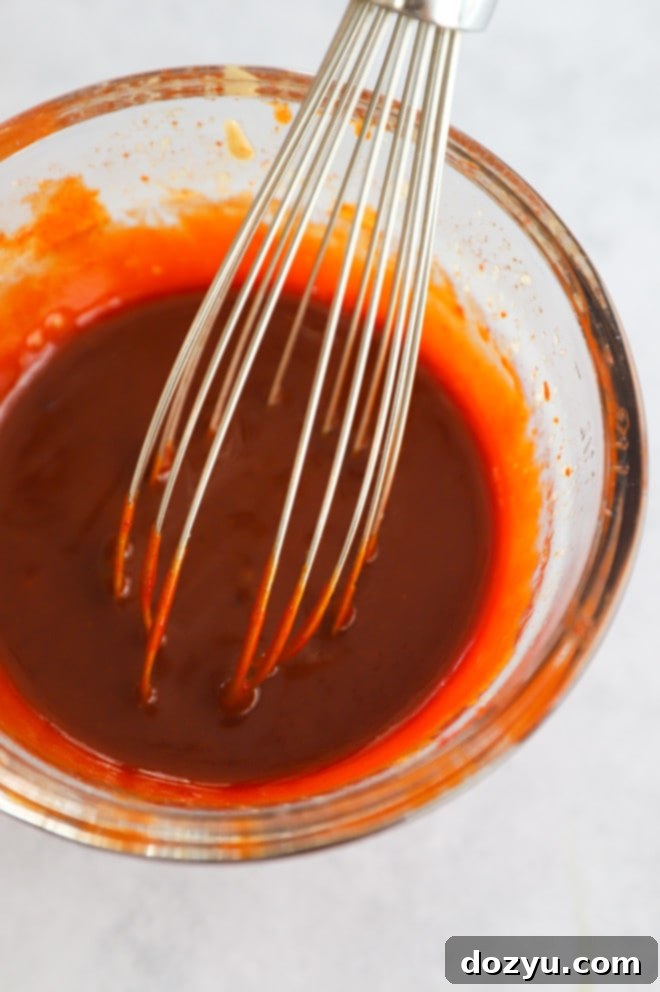
Must-Have Kitchen Tools for Noodle Perfection
One of the many joys of this Gochujang Noodles recipe is how straightforward it is, requiring only a few basic kitchen essentials that most home cooks already own. You don’t need any fancy equipment to achieve a restaurant-quality meal. Here’s what you’ll need to gather:
- Large Pot or Saucepan: Essential for boiling your noodles to al dente perfection. A spacious pot ensures the noodles have enough room to cook evenly without clumping.
- Small Mixing Bowl: This is where the magic of the sauce happens! A small bowl is ideal for combining and whisking all the sauce ingredients thoroughly.
- Whisk: A good whisk is key to achieving a perfectly smooth and emulsified gochujang sauce, ensuring all the flavors are evenly distributed.
- Wok or Large Skillet: The workhorse of this recipe! A wok, with its high sides and curved bottom, is fantastic for stir-frying as it distributes heat evenly and allows for easy tossing. If you don’t have a wok, a large, deep skillet will work just as well to combine all the components.
- Tongs or “Clongs”: These are incredibly useful for tossing the noodles, chicken, and spinach with the sauce in the wok or skillet, ensuring every strand is coated and perfectly mixed.
With these simple tools at your disposal, you’re all set to whip up a batch of these incredibly flavorful Korean Gochujang Noodles!
Crafting Your Gochujang Noodles: Step-by-Step Guide
Making these spicy gochujang noodles is a breeze, even for beginner cooks. Follow these simple steps to bring a burst of Korean flavor to your table in under 15 minutes!
Step 1: Prepare Your Noodles to Perfection
Begin by bringing a large pot of generously salted water to a rolling boil over high heat. Once boiling, add your chosen noodles (lo mein, udon, or ramen work great). Cook them according to the package instructions, being careful not to overcook, as mushy noodles can ruin the texture of the dish. Al dente is key! Once cooked, drain the noodles thoroughly in a colander and rinse them under cold water. This crucial step stops the cooking process, removes excess starch, and prevents the noodles from sticking together, ensuring a perfect texture when combined with the sauce.
Step 2: Whisk Up the Flavorful Gochujang Sauce
While your noodles are cooking, it’s time to create the star of the show: the rich gochujang sauce. In a small mixing bowl, combine the gochujang paste, soy sauce, light or dark brown sugar, tahini, toasted sesame oil, and two tablespoons of water. Using a whisk until all ingredients are thoroughly combined and the sauce is smooth. You’ll want a consistent, vibrant mixture without any lumps.
Now for the most important part: taste the sauce! This is your opportunity to customize the flavors to your preference. If you prefer it spicier, add a little more gochujang paste. For more savory depth, a splash more soy sauce will do the trick. If you find it needs a touch more tang, a teaspoon or two of fresh lime juice can brighten it up. Craving more umami? Stir in a bit more tahini. If the acidity is too strong or you just like a sweeter profile, an extra pinch of brown sugar will balance it out. Adjusting the sauce at this stage ensures your final dish is exactly how you like it.
Step 3: Bringing It All Together in the Wok
Heat two tablespoons of vegetable oil in a wok or large skillet over medium-high heat. Once the oil is shimmering and hot, add the finely chopped garlic and sauté for about 30 seconds until it becomes wonderfully fragrant – be careful not to burn it! Pour in your prepared gochujang sauce and, stirring constantly, cook until it visibly thickens, which typically takes about 2 minutes. This step helps to intensify the flavors and create a luscious coating for your noodles.
Next, add the drained noodles, fresh spinach, shredded chicken, and torn basil leaves to the skillet. Using tongs, toss everything together vigorously until the spinach has wilted and all ingredients are evenly coated in the rich, spicy sauce, about 2 minutes. The goal is to heat everything through and integrate the flavors.
Serve immediately! The longer these noodles sit, the stickier the sauce can become, though a little water can fix it during reheating. Garnish with a sprinkle of toasted sesame seeds and thinly sliced scallions (green onions) for extra flavor and visual appeal, if desired.
Pro Tip: If the sauce appears too thick or sticky at any point, simply add a tablespoon or two of water to the pan to loosen it up and achieve your desired consistency.
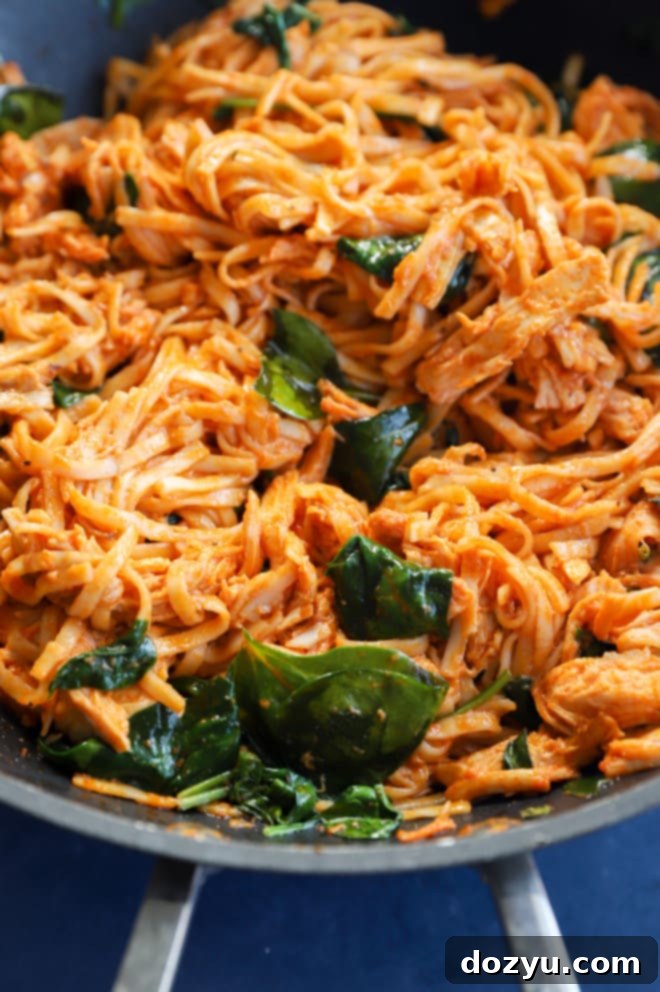
Delicious Variations and Customization Ideas
The beauty of these Gochujang Noodles lies in their incredible adaptability. This base recipe is a canvas for your creativity, allowing you to easily switch up ingredients and tailor the dish to your taste, dietary needs, or whatever you have on hand. Here are some of our favorite ways to customize and enjoy this flavorful meal:
- Protein Power-Ups: While shredded rotisserie chicken is convenient and delicious, feel free to experiment with other proteins. Swap it out for shredded skinless chicken thighs for a richer flavor, or use ground beef, ground chicken, ground pork, or even ground turkey for a different texture. If you have leftover pulled pork, that would be fantastic too! For plant-based eaters, consider firm tofu (pressed and cubed or crumbled), tempeh, or seitan, sautéed until golden before adding to the sauce.
- Veggie Boost: Transform these noodles into a full-blown stir-fry by adding a rainbow of sautéed vegetables. Excellent additions include thinly sliced carrots, zucchini ribbons, colorful bell peppers (red, yellow, orange), finely chopped jalapeños for extra heat, crisp broccoli florets, shredded cabbage, bok choy, sliced mushrooms, or crunchy snap peas. Sauté these veggies lightly before adding the sauce to maintain their texture.
- Leafy Green Alternatives: If spinach isn’t your favorite or isn’t available, chopped kale is a hearty alternative. Just be aware that kale will need a slightly longer cooking time to wilt down compared to spinach. Other leafy greens like Swiss chard or mustard greens could also be used for a more adventurous twist.
- Tahini Swap for a Nutty Spin: Don’t have tahini? No problem! Smooth peanut butter can be a surprisingly delicious substitute. It will lend a similar creamy texture and nutty depth to the sauce, but with a distinct peanut flavor instead of sesame. Adjust the sweetness slightly if your peanut butter is already sweetened.
- Noodle Adventures: The world of noodles is vast! Beyond lo mein, udon, and ramen, consider wider flat rice noodles for a different mouthfeel, or even thinner vermicelli noodles for a lighter dish. For a completely gluten-free option, rice noodles are perfect. For a low-carb alternative, zucchini noodles (zoodles) or spaghetti squash strands can also be used, though they should be added at the very end to prevent them from becoming watery.
- Egg-cellent Topping: For an extra layer of richness and protein, top your bowl of noodles with a perfectly fried or poached egg. A runny yolk cascading over the spicy noodles is truly a game-changer!
Craving more Korean-inspired flavors? Explore these exciting recipes: Korean Turkey Lettuce Wraps | Korean Spicy Chicken Rice Bowls | Crispy Korean BBQ Chicken Wings | Spicy Korean Chicken Thighs | Kimchi Udon
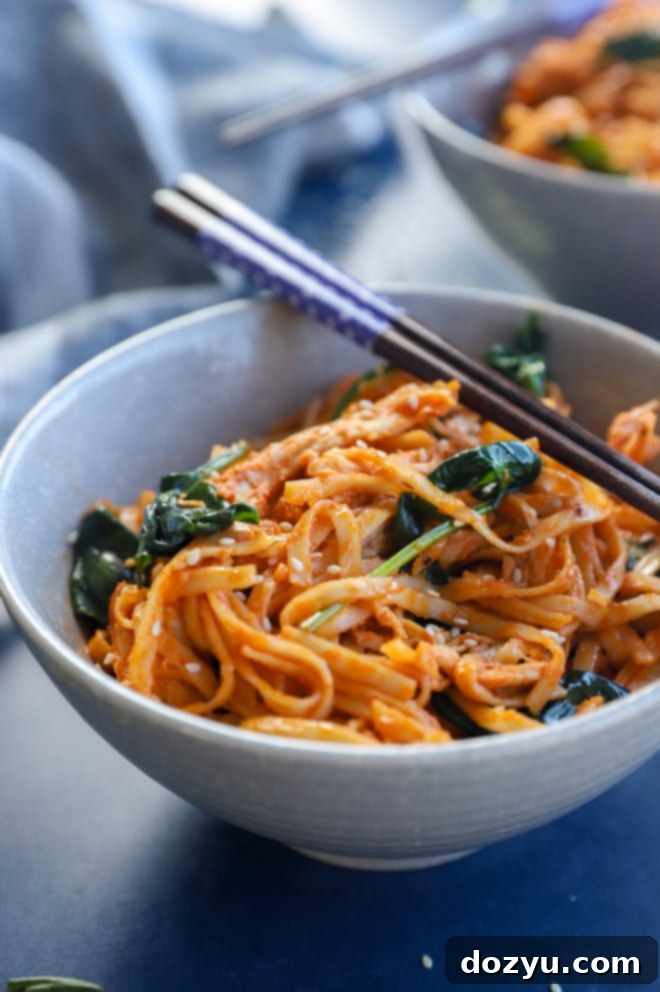
Frequently Asked Questions About Gochujang Noodles
Here are answers to some common questions about making and enjoying these spicy Gochujang Noodles:
Can I Make Gochujang Noodles Vegetarian or Vegan?
Absolutely! To make this dish vegetarian, simply replace the cooked chicken with your favorite plant-based protein. Excellent choices include pan-fried or baked tofu (extra firm works best), seitan, or even hearty mushrooms like shiitake or cremini. You can also entirely omit the protein and instead load up on additional sautéed vegetables, such as bell peppers, broccoli, carrots, or bok choy, to make the noodle dish more substantial and filling. For a vegan version, ensure your noodles are egg-free, use a plant-based shredded chicken substitute or tofu, and make sure your gochujang and soy sauce are vegan-friendly (most are, but always check labels!).
Can I Scale This Recipe for More Servings?
Yes, you can definitely double or even triple this recipe to feed a larger crowd or for meal prepping! Just be sure to use your largest wok or skillet to accommodate the increased volume of ingredients. This dish makes fantastic leftovers for a couple of days, providing delicious lunches or quick dinners. Keep in mind that the noodles can become a bit stickier as they sit; however, this is easily remedied by adding a splash of water when reheating, as detailed in our storage section.
How Spicy Are These Gochujang Noodles, and Can I Adjust the Heat?
These noodles definitely pack a noticeable kick, thanks to the potent gochujang paste! The base recipe offers a medium heat level – it’s present and invigorating without overwhelming your taste buds. If you’re a heat-seeker, feel free to increase the amount of gochujang paste in the sauce to achieve a fierier experience. Conversely, if you’re sensitive to spice, you can reduce the amount of gochujang. The best part is that you prepare the sauce separately before adding it to the other ingredients, giving you the perfect opportunity to taste and adjust the spice level to your exact preference before committing!
Gochujang Paste vs. Gochujang Sauce: What’s the Difference?
Understanding the distinction between gochujang paste and gochujang sauce is crucial for this recipe. Gochujang paste, the ingredient used here, is a thick, concentrated, and very potent fermented chili paste. It’s unadulterated and delivers maximum flavor and heat. Gochujang sauce, on the other hand, is typically a pre-mixed condiment that has been thinned out with other ingredients like vinegar, soy sauce, and sweeteners. It has a much thinner consistency and a milder, often sweeter flavor profile. For the rich, robust taste intended for these noodles, always opt for the pure gochujang paste.
What are the Best Noodles for This Recipe?
While this recipe is versatile, some noodles perform better than others. Lo mein, udon, or ramen noodles (without their seasoning packets) are excellent choices due to their sturdy texture and ability to absorb the rich sauce without becoming mushy. Udon noodles offer a delightfully chewy bite, while lo mein noodles are great for stir-fries. For a lighter texture, consider thin rice vermicelli, or for a gluten-free option, wide flat rice noodles work beautifully. The key is to choose a noodle that can hold up to the hearty sauce and ingredients.
Can I Prepare Any Part of This Dish in Advance?
Yes, you can certainly do some prep work ahead of time to make dinner even faster! The gochujang sauce can be whisked together and stored in an airtight container in the refrigerator for up to 3-4 days. You can also shred your chicken or chop your garlic in advance. While you can cook the noodles ahead of time, they are best when freshly cooked and rinsed, then added to the hot sauce right before serving to maintain their ideal texture. For maximum freshness and flavor, it’s best to assemble the entire dish just before eating.
Seeking more quick and easy noodle or pasta dishes? Explore our extensive pasta recipes page for endless inspiration!
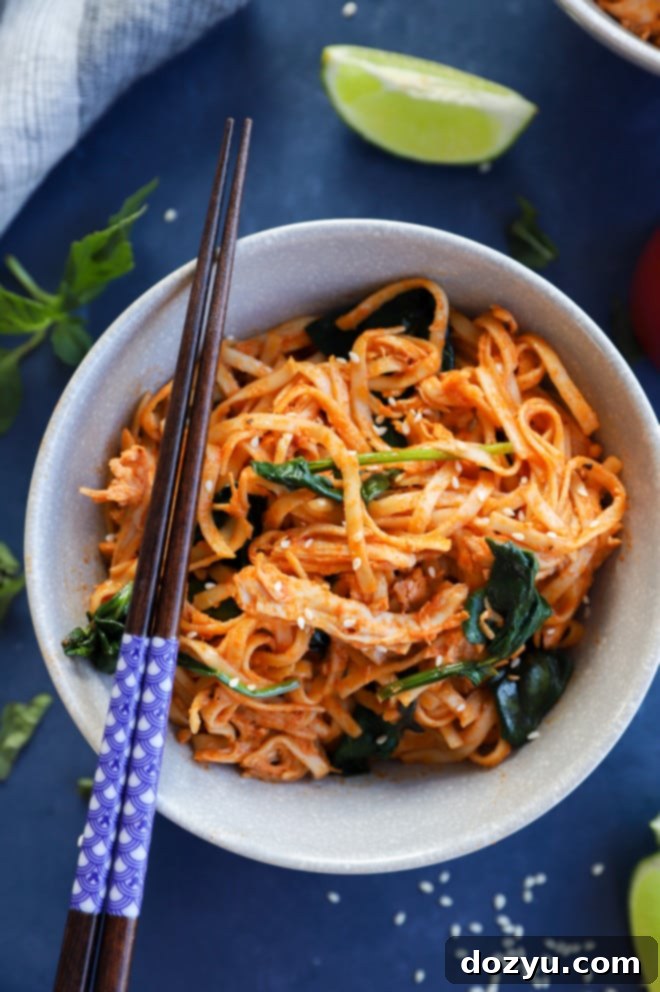
Perfect Pairings: What to Serve with Your Spicy Noodles
These spicy gochujang noodles are incredibly satisfying on their own, as they encompass a full meal with protein, vegetables, and carbohydrates all in one bowl. However, enhancing the experience with a selection of complementary toppings can truly elevate the dish and allow everyone to customize their plate. My family loves to gather around a table laden with various garnishes to personalize each serving. Here’s a list of fantastic additions to offer:
- Fresh Lime Wedges: A squeeze of fresh lime juice at the table adds a bright, zesty finish that perfectly cuts through the richness and spice of the noodles.
- Toasted Sesame Seeds: These tiny seeds provide a delightful crunch and an extra layer of nutty flavor, complementing the sesame oil and tahini in the sauce.
- Extra Sesame Oil: A tiny drizzle of additional toasted sesame oil just before eating can boost its distinctive aroma and taste.
- Fresh Herbs: Beyond basil, consider offering freshly chopped cilantro, chives, or thinly sliced green onions (scallions). These vibrant herbs add freshness and a pleasant bite. Feel free to use a combination!
- Extra Heat Boosters: For those who crave even more spice, small bowls of sriracha, a dollop of gochujang sauce (the milder condiment version), or a drizzle of spicy chili oil can be game-changers.
While the noodles themselves are a complete meal, if you’re hosting a dinner party or simply want to expand the spread, you could begin the meal with some classic Asian-inspired appetizers. Crispy spring rolls or savory potstickers would set a wonderful tone and keep with the theme.
To complement the spicy and rich flavors, a refreshing beverage is highly recommended. This bright and invigorating Green Tea Vodka Cocktail makes an excellent adult pairing, offering a cool contrast to the warmth of the noodles. For a non-alcoholic option, consider a crisp sparkling water with lime or a simple iced green tea.
And if you’re looking for a super easy, sweet ending to your meal, these three-ingredient Nutella Cake Bites are a delightful and quick dessert that requires minimal effort.
Storage and Reheating Tips for Leftovers
Having leftovers of these delicious Gochujang Noodles is a bonus! Proper storage and reheating will ensure you can enjoy them for another day or two.
- Storage: To store any uneaten noodles, allow them to cool completely to room temperature. Then, transfer them to an airtight container and place them in the refrigerator. For best quality and texture, I recommend consuming leftovers within 1 to 2 days. The noodles, especially wheat-based varieties, tend to absorb more sauce and can become stickier the longer they sit.
- Freezing: I generally do not recommend freezing this recipe. Noodles, particularly stir-fry noodles, can change texture significantly after freezing and thawing, often becoming mushy. The sauce might also separate, losing its smooth consistency. This dish is best enjoyed fresh or as a quick leftover within a day or two.
- Reheating: To reheat, transfer your desired portion of noodles to a microwave-safe dish. Heat in the microwave on medium power, stirring occasionally, until warmed through. Alternatively, you can reheat them in a skillet over medium heat on the stovetop. A common issue with leftover noodles is that they can become quite sticky or clumped together. Don’t worry, this is easily fixed! As you reheat, add a tablespoon or two of water (or chicken/vegetable broth for extra flavor) to the pan or dish. Stir gently to loosen up the sauce and rehydrate the noodles, bringing them back to a wonderfully saucy consistency.
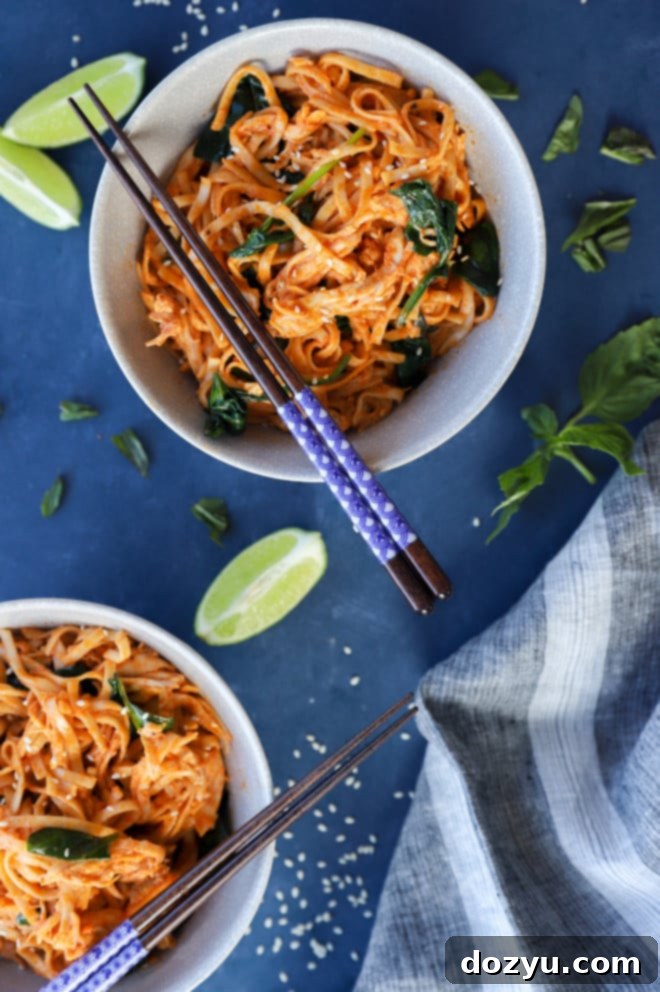
We truly hope you enjoy making and savoring these Spicy Gochujang Noodles! If you give this recipe a try, please consider leaving a star rating and a comment on the recipe card below. Your feedback is incredibly valuable to us, and we love hearing about your culinary creations and answering any questions you might have.
Don’t forget to tag us on Instagram, Facebook, or Pinterest if you share photos of your delicious noodles! Seeing our recipes come to life in your homes is truly the highlight of our day.
Stay connected and be the first to know about new recipes and culinary tips by signing up for our newsletter!
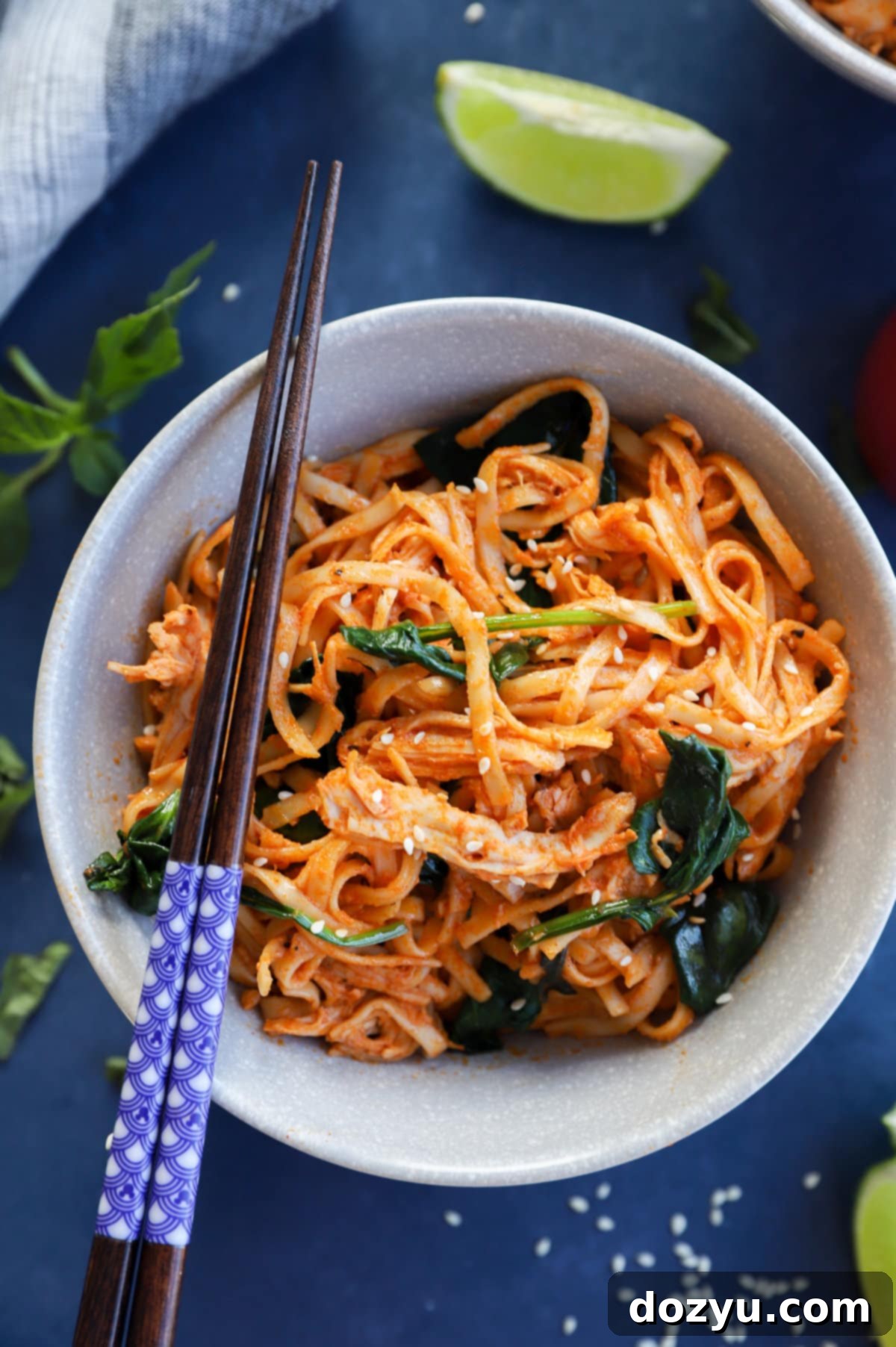
Gochujang Noodles
equipment
-
Measuring Spoons
-
Measuring Cups
-
mixing bowls
-
French Wire Whisk
-
9-Inch Tongs
-
Carbon Steel Wok Pan
Ingredients
- 8 to 10 oz fresh or dried wheat noodles such as lo mein, udon, or ramen
- 1/4 cup gochujang paste
- 1/4 cup soy sauce
- 2 Tbsp light or dark brown sugar
- 2 Tbsp tahini
- 1 1/2 Tbsp fresh lime juice
- 2 tsp toasted sesame oil
- Salt and pepper to taste
- 2 Tbsp vegetable oil
- 4 garlic cloves finely chopped or minced
- 1 1/2 cups loose-packed fresh spinach
- 1 lb shredded chicken homemade or rotisserie chicken works great here!
- Handful of torn fresh basil leaves plus sprigs for serving
- For serving: fresh basil leaves lime wedges, salt, chili oil, sesame seeds, sesame oil, sliced scallions, etc.
Instructions
-
Bring a pot of salted water to a boil over high heat. Cook noodles according to the package instructions. Drain and rinse under cold water.
-
While the noodles are cooking, whisk together gochujang paste, soy sauce, brown sugar, tahini, sesame oil, and 2 Tablespoons water in a small bowl until well combined.
-
Taste the sauce now! This is where you can adjust the flavoring to make it spicier, add more salt with soy sauce, or even add a touch of acid if you like with a teaspoon or two of lime juice. If you want more umami flavor, add in a little more tahini or you can add in some more sugar if it’s too acidic.
-
Heat vegetable oil in a wok or large skillet over medium-high heat. Once hot, add garlic and cook until fragrant, about 30 seconds. Add sauce and, stirring constantly, cook until thickened, about 2 minutes.
-
Add noodles, spinach, chicken, and basil. Toss together and cook until spinach is wilted, about 2 minutes.
-
Serve immediately with your preferred toppings like sesame seeds, scallions, or extra lime wedges.
